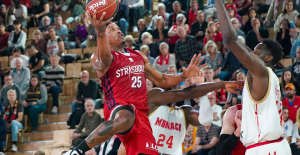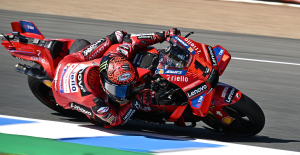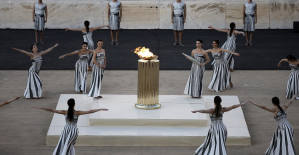In the distance, a dull howl sounds through the jungle, half growl, half roar. An eerie sound that is a strange contrast to this peaceful early morning. The water of the Rio Ariaú, a channel-like tributary of the Rio Negro in Brazil, lies as smooth as glass, like liquid silver; the west bank of the river, which is densely wooded on both sides, is illuminated by the morning sun that has risen an hour ago. Blue-and-yellow macaws sit on the branches of a treetop, swinging up in pairs for a flight circuit high above the water.
The bizarre soundtrack is not caused by the colorful birds, but by a couple of howler monkeys - they remain invisible, which makes the whole thing even more sinister. "Their calls can be heard up to five kilometers away, you hardly ever see them," says Raphael Rocha Sa and a little later he draws attention to a capuchin monkey in the dense green of the river bank. Later he points to a black structure in a branch fork: a termite nest. The insects settle here at dizzy heights, as the ground is regularly flooded.
Rocha Sa is expedition leader on the "Jangada", a 12-cabin boutique ship commissioned in 2019, which is very comfortable for exploring Amazonia. It's one of only a handful of passenger ships operating on the Amazon and its tributaries such as the Rio Ariaú.
Unlike, for example, on the Nile, which almost looks like a cruise ship assembly line, here you are alone on a wide corridor or river wave. Because although boats are the only means of transport and the river is the only traffic artery, during the days on board you only see a few river dwellers who are out and about on the water.
The "Jangada" is named after Jules Verne's 1881 novel "The Jangada". 800 miles on the Amazon”, in which the plantation owner Joam Garral, his family, priests and a large group of servants embark on a huge raft – a Jangada – on the journey from the Peruvian border to Belém.
Bernard Ramus, the French owner of the "Jangada", devoured the book as a youth, it made him dream of adventures and this far, exotic region. The Frenchman has traveled widely, as a 21-year-old he drove from Paris to Kabul and back in a 2CV, for five decades his life has been played out between Brazil and France. When Ramus was looking for a name for the river boat he had designed, it quickly became clear what it should be called.
The 29 meter long catamaran, which is more like a houseboat than a traditional river steamer, as you might know it from the Werner Herzog film "Fitzcarraldo", starts its expedition tours from the Amazon metropolis of Manaus. The furthest leads in just under two weeks to Tabatinga, where Brazil meets Colombia and Peru, and follows Jules Verne's footsteps.
The special feature: With its shallow draft of 1.4 meters, the ship can explore the extensive, highly ramified river system even in the dry months when the water level is low. For the daily excursions, the "Jangada" has two dinghies in tow.
Manaus became famous as the 'Paris of the Tropics' during the rubber boom between 1870 and 1910 - its spectacular opera house with chandeliers from Murano and mirrors from Belgium dates from this period. In the jungle city, the Rio Solimões and Rio Negro unite, from then on they flow together as the Amazon towards the Atlantic coast.
Even if the water of the Rio Negro (Black River) is not really black, it is actually very dark, like black tea. At that time, the rubber barons who respected themselves sent their laundry to Portugal to be washed instead of having them cleaned in the local river. But the water was and is not dirty, but rather unusually dark due to its high acidity. It is also low in nutrients, so there are almost no mosquitoes on and around it.
The water of the Rio Solimões, on the other hand, is as milky as latte macchiato because of the sediment it carries. Because the temperatures of the two streams are also different, they flow side by side in the same bed for kilometers until their water finally mixes.
This encontro das águas (meeting of the waters) near Manaus is an impressive natural phenomenon that can be observed particularly well from the upper deck of the ship. The black and white play of the rivers can also be found in the cityscape: as a light and dark striped wooden floor in the opera house, as a black and white wave pattern made of cobblestones on the square in front of the building.
Or in the “Amazonas” dessert at the “Caxiri” restaurant. Comida Amazonica”: light Brazil nut ice cream with dark chocolate sauce and Brazil nut brittle. The restaurant is a popular Instagram spot with its raw brick walls, mint green ceilings and green plant decorations. It is dedicated to an ambitious but not over-the-top regional cuisine and also offers a fantastic view of the opera.
At least 6,400 kilometers long, the Amazon is not only a mighty river, but also the name of the largest Brazilian state. The Amazon Basin, in turn, stretches across eight countries and three time zones, with Brazil accounting for around two-thirds. It covers an area of around six million square kilometers, which is about twice the size of India. Around 30 percent of the world's tropical rainforest is located here, so Amazonia is responsible for 20 percent of the oxygen produced by photosynthesis on land. It is home to around 40,000 plant species and over 3000 fish species.
But diversity is threatened: "17 percent of the rainforest has already been destroyed," says Raphael Rocha Sa. "One of the greatest dangers are cattle breeding and soybean cultivation, both go hand in hand." Agriculture needs land, and more and more is being used for this Rainforest cleared, mainly east of Manaus in the state of Para, where gas and oil would also be extracted. “I would like to see international efforts to better protect the Amazon. People think too little about the future.”
If you fly over the area from São Paulo in the direction of Manaus on a clear day, it looks like a graphic pattern of monstera leaves from a great height with its countless rivers, canals and tributaries. As the plane descends, the dense rainforest looks like a large bed of green moss.
You can also explore it on foot with a guide. During a hike in the rain forest on the edge of the Anavilhanas archipelago, Rocha Sa shows the rubber booted excursion participants some of the more than 6000 different tree species (for comparison: there are just 265 in Europe): fan palms, for example, which are used to cover roofs, or the armesque Tree whose aromatic white resin was burned the night before in the meeting house, the “House of Wisdom” of the Cipiá indigenous community, and which is used for spiritual healing.
The Copaíba tree, whose essential oil is used to treat injuries, but also to treat a sore throat or stomach ache. Or the up to 20 meter high bacaba palm, whose fruits are rich in omega-3 fatty acids and are processed into baby food, among other things. An endless wealth of nature.
The jungle guide, who learned his knowledge from his grandmother, crushes small red ants on his skin and lets visitors sniff. It smells of forest and a bit of tea tree oil. "A natural anti-mosquito agent," says Rocha Sa.
He prefers to keep his distance from other ants – up to seven million of these insects live on a hectare of rainforest: years ago he was stung by a black 24-hour ant the size of a fingernail (bullet ant), whose poisonous sting is just as painful as it is torturous and leads to paralysis. He had to be carried out of the forest and lay motionless for a day.
The anecdote is another argument for the number one jungle rule: "Do not touch anything!" It was drilled into the group, who are now moving in single file through the rainforest, even before they got off the boat. Everyone walks extremely carefully, no one wants to have to lean on a tree trunk.
The excursion is acoustically accompanied again and again by the penetrating calls of the Capitão do mato (slave hunter). The inconspicuous grey-brown bird sounds when intruders approach - in this case the ship's passengers - it sounds like a mixture between a smoke detector warning tone and a car alarm.
Back on the "Jangada", which is moored on the banks of the Rio Cuieiras, a branch of the Rio Negro about 60 kilometers upstream from Manaus. Here you have the opportunity to swim from the boat. Absolutely safe, ship owner Bernard Ramus had emphasized.
But for people who feel most comfortable in tiled pools, the dark water is quite a challenge. You don't even have to go to horror movies with killer piranhas and monster anacondas. The still fresh impressions from the visit to the fish market in Manaus are enough to consider a river bath to be unnecessary.
For example, there was the gigantic tambaqui (millstone salmer) with shiny brass-colored scales, which grows up to one meter tall and weighs up to 30 kilograms, and whose teeth are disturbingly similar to those of a human. A person with slightly rotten teeth. It uses its strong jaws to crack Brazil nuts, its favorite food. Luckily he's a vegetarian. And an excellent food fish.
The elongated, silvery pirarucu, on the other hand, is one of the largest freshwater fish in the world, reaching up to two meters in length. At the market, a seller had lifted a not-so-long specimen with a grin on his face for a photo. A predatory fish. And then there were these dark brown, primeval-looking, lung- and shell-equipped fish, still squirming, very much alive, on the stainless-steel tables.
Actually, you don't want to meet any of these beasts while swimming. But in the end, the monster visions are pushed aside by at least part of the tour group. Curiosity, a thirst for adventure and the knowledge that the chance to splash around in the Amazon will probably not come again win out.
The water is warm and soft, almost velvety, its dark color giving the bodies of the swimmers in the river a skin tone like after three weeks of beach vacation. A tan that disappears as soon as the bathers step out of the unusual water. No aquatic life can be seen; no river dolphins either, which are actually almost unreal pink and of which the passengers keep spotting a few from the ship.
Later, on Lake Acajatuba, there will be the opportunity to literally meet the dolphins with the characteristic bump over their snouts up close. What originally began as a therapy project for autistic children with free-living dolphins is now also open to tourists.
The simple term river cruise does not do justice to this extraordinary journey, because this huge water system is so wide in places that no shore can be seen and you have the feeling of being on a sea. The Amazon and its source rivers form water loops and lakes, dead-straight canals, secluded side arms that branch out more and more, a labyrinth of water and vegetation.
In the Anavilhanas archipelago, around 100 kilometers from Manaus, the Rio Negro is up to 27 kilometers wide. In the dry season around 400 islands are formed here, the largest river island archipelago in the world; in the rainy season the jungle is flooded - Igapó is called the Amazonian alluvial forest.
The next day, the sighting of a sloth causes sighs of delight from travelers. Raphael Rocha Sa discovers the shy animal while standing at the bow of the excursion boat with binoculars. It hangs from a branch, well camouflaged, barely visible to the untrained eye. Its fur has the same markings as the bark of the tree it hangs from. A strange animal, almost ugly, but somehow touching. Does the expression "hang out" go back to being a sloth? It moves as slow as the river.
In general, the encounter with the sloth is a good symbol for this journey: wild and exotic, at the same time an exercise in deceleration and attentive observation.
Entry rules: You do not need a visa for Brazil, the passport must be valid for six months. Travelers from Europe must either present proof of a corona vaccination or a negative test result that is no more than 24 hours old. Be sure to pack: high hiking shoes for a good grip on jungle excursions on foot. And binoculars for nature cinema.
Amazon Travel: Expedition cruises with the "Jangada" are offered exclusively by the organizer Lernidee Erlebnisreisen for the German-speaking region. For example in combination with Rio, the Pantanal, the Iguaçu waterfalls and Brasília with a six-day Amazon river cruise (18 days from 7920 euros, with flights from/to Germany) or as a 16-day expedition "1000 miles on the Amazon". 13-day river cruise from Manaus to Tabatinga or vice versa (from 6620 euros with flights from/to Germany); Combined trips with other South American destinations are also possible, lernidee.de.
Phoenix Reisen is offering an eight-day trip to the Amazon as part of a 13-day trip with Iguaçu and Rio (from 4399 euros with flights from/to Germany), phoenixreisen.com.
Amazon Antonio Jungle Tours is a local operator that offers multi-day tours on the Rio Urubu from Manaus, antonio-jungletours.com.
Travel reading: Jules Verne's novel "The Jangada. 800 Miles on the Amazon” was reissued in spring with the illustrations from the 1901 edition (Other Library, 22 euros).
Participation in the trip was supported by Lernidee Erlebnisreisen. You can find our standards of transparency and journalistic independence at axelspringer.com/de/Werte/downloads.

 War in Ukraine: when kyiv attacks Russia with inflatable balloons loaded with explosives
War in Ukraine: when kyiv attacks Russia with inflatable balloons loaded with explosives United States: divided on the question of presidential immunity, the Supreme Court offers respite to Trump
United States: divided on the question of presidential immunity, the Supreme Court offers respite to Trump Maurizio Molinari: “the Scurati affair, a European injury”
Maurizio Molinari: “the Scurati affair, a European injury” Hamas-Israel war: US begins construction of pier in Gaza
Hamas-Israel war: US begins construction of pier in Gaza First three cases of “native” cholera confirmed in Mayotte
First three cases of “native” cholera confirmed in Mayotte Meningitis: compulsory vaccination for babies will be extended in 2025
Meningitis: compulsory vaccination for babies will be extended in 2025 Spain is the country in the European Union with the most overqualified workers for their jobs
Spain is the country in the European Union with the most overqualified workers for their jobs Parvovirus alert, the “fifth disease” of children which has already caused the death of five babies in 2024
Parvovirus alert, the “fifth disease” of children which has already caused the death of five babies in 2024 Inflation rebounds in March in the United States, a few days before the Fed meeting
Inflation rebounds in March in the United States, a few days before the Fed meeting Video games: Blizzard cancels Blizzcon 2024, its annual high mass
Video games: Blizzard cancels Blizzcon 2024, its annual high mass Falling wings of the Moulin Rouge: who will pay for the repairs?
Falling wings of the Moulin Rouge: who will pay for the repairs? “You don’t sell a company like that”: Roland Lescure “annoyed” by the prospect of a sale of Biogaran
“You don’t sell a company like that”: Roland Lescure “annoyed” by the prospect of a sale of Biogaran Exhibition: in Deauville, Zao Wou-Ki, beauty in all things
Exhibition: in Deauville, Zao Wou-Ki, beauty in all things Dak’art, the most important biennial of African art, postponed due to lack of funding
Dak’art, the most important biennial of African art, postponed due to lack of funding In Deadpool and Wolverine, Ryan and Hugh Jackman explore the depths of the Marvel multiverse
In Deadpool and Wolverine, Ryan and Hugh Jackman explore the depths of the Marvel multiverse Tom Cruise returns to Paris for the filming of Mission Impossible 8
Tom Cruise returns to Paris for the filming of Mission Impossible 8 Skoda Kodiaq 2024: a 'beast' plug-in hybrid SUV
Skoda Kodiaq 2024: a 'beast' plug-in hybrid SUV Tesla launches a new Model Y with 600 km of autonomy at a "more accessible price"
Tesla launches a new Model Y with 600 km of autonomy at a "more accessible price" The 10 best-selling cars in March 2024 in Spain: sales fall due to Easter
The 10 best-selling cars in March 2024 in Spain: sales fall due to Easter A private jet company buys more than 100 flying cars
A private jet company buys more than 100 flying cars This is how housing prices have changed in Spain in the last decade
This is how housing prices have changed in Spain in the last decade The home mortgage firm drops 10% in January and interest soars to 3.46%
The home mortgage firm drops 10% in January and interest soars to 3.46% The jewel of the Rocío de Nagüeles urbanization: a dream villa in Marbella
The jewel of the Rocío de Nagüeles urbanization: a dream villa in Marbella Rental prices grow by 7.3% in February: where does it go up and where does it go down?
Rental prices grow by 7.3% in February: where does it go up and where does it go down? Even on a mission for NATO, the Charles-de-Gaulle remains under French control, Lecornu responds to Mélenchon
Even on a mission for NATO, the Charles-de-Gaulle remains under French control, Lecornu responds to Mélenchon “Deadly Europe”, “economic decline”, immigration… What to remember from Emmanuel Macron’s speech at the Sorbonne
“Deadly Europe”, “economic decline”, immigration… What to remember from Emmanuel Macron’s speech at the Sorbonne Sale of Biogaran: The Republicans write to Emmanuel Macron
Sale of Biogaran: The Republicans write to Emmanuel Macron Europeans: “All those who claim that we don’t need Europe are liars”, criticizes Bayrou
Europeans: “All those who claim that we don’t need Europe are liars”, criticizes Bayrou These French cities that will boycott the World Cup in Qatar
These French cities that will boycott the World Cup in Qatar Basketball: Strasbourg appeals the victory recovered by Monaco
Basketball: Strasbourg appeals the victory recovered by Monaco Top 14: UBB with Tatafu and Moefana against Bayonne
Top 14: UBB with Tatafu and Moefana against Bayonne MotoGP: Bagnaia dominates qualifying practice in Spain and sets track record
MotoGP: Bagnaia dominates qualifying practice in Spain and sets track record Olympic Games: in Athens, Greece transmits the Olympic flame to France
Olympic Games: in Athens, Greece transmits the Olympic flame to France


















